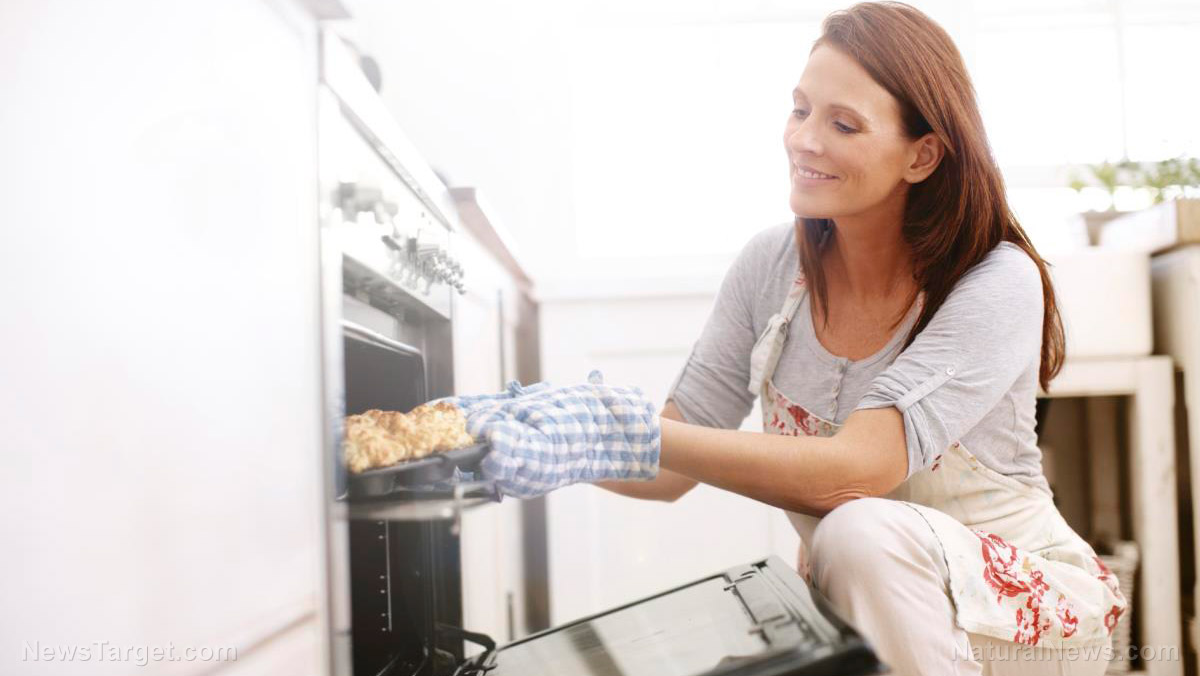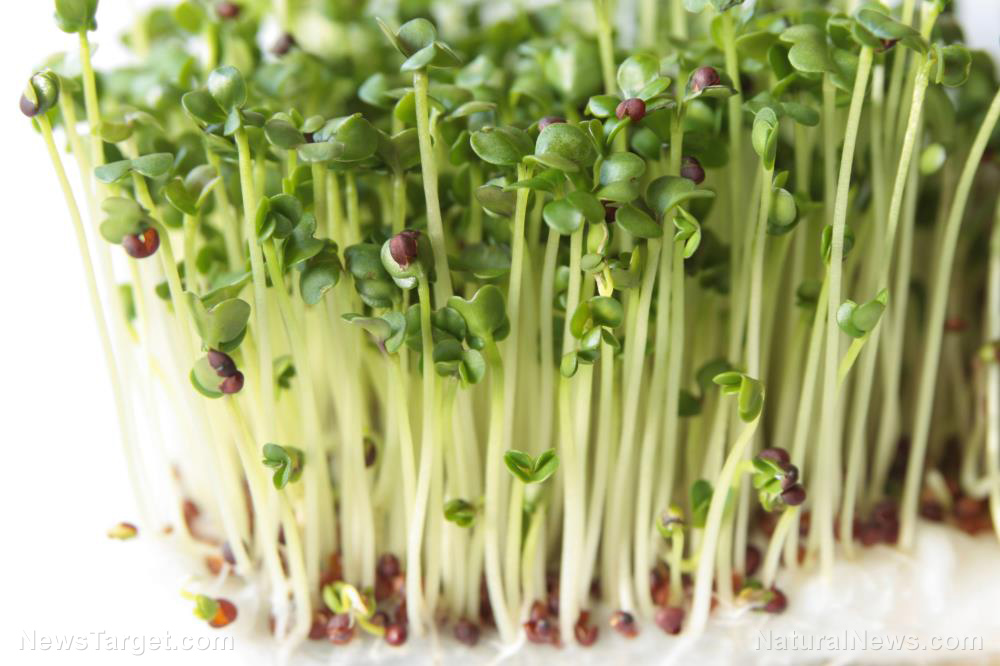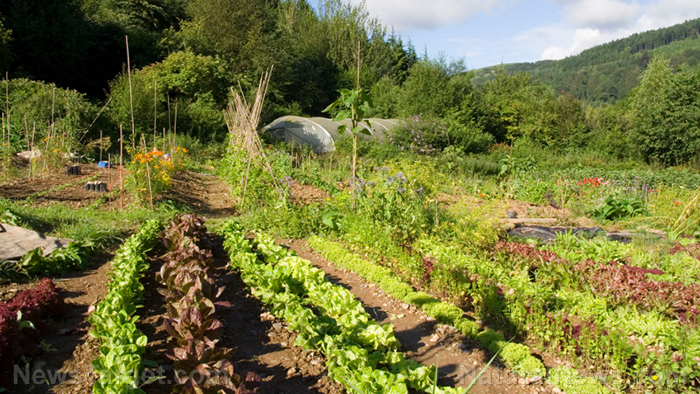Homemade recipes: No-knead artisan bread
12/09/2022 / By Zoey Sky

Enjoying a warm loaf of artisan bread for breakfast is a great way to start your day, but the costs can add up if you buy bread too often.
To save money, learn how to make delicious no-knead artisan bread at home. The recipe below only takes about five minutes a day and only requires five ingredients you may already have at home.
The final product is a loaf of bread with a soft and fluffy inside with a crunchy crust. (Related: 8 Survival bread recipes for preppers.)
Baking equipment you may need
These tools aren’t required, but having them will make it easier to bake the bread at home.
- You can use a Banneton dough-proofing bowl or proofing basket to help form a nice dome on top of round bread loaves. Using a proofing basket lets the dough breathe as it proofs.
- A bread lame is a razor blade used to cut the top of the dough without tearing it or burning yourself while the bread is still in a preheated Dutch oven.
- A cast-iron bread baking Dutch oven is sturdy. You can use the lid as a skillet and it doesn’t have an enamel coating that is easy to scratch or damage.
- Use a wooden bench knife to separate the dough without getting it stuck to your hands. The knife can also be used to form the loaf and for easy cleanup.
- A wooden dough scraper makes it easier to scrape the dough out of the bowl
The whole family will love this freshly baked bread, which is best used to make garlic bread, various sandwiches, or torn and dipped into a hearty soup. Fresh bread is also a great snack with a dollop of butter.
Ingredients for no-knead artisan bread master dough
Ideally, if you want to bake bread you should already have this dough sitting in the refrigerator. This helps save time instead of gathering ingredients to bake a fresh loaf of bread or having to let your dough rise to room temperature first.
This dough works best straight from the fridge, but if this is your first time baking this bread, you will need to make the “master dough.”
You need the following ingredients to make the master dough:
Flour
You can use whole wheat or fresh ground flour, but reduce the flour to five and a half cups and increase only if the dough is too wet and won’t hold its shape.
Avoid measuring errors by spooning the flour into a measuring cup and leveling it with the edge of a dull knife.
Salt
You can use sea salt, but if you don’t have it table salt will do.
Vinegar
The recipe requires apple cider vinegar. You can also use other kinds of vinegar to help create a better texture in no-knead bread recipes.
Water
The master dough needs water that is warm enough to activate yeast, but not so hot that it kills it.
If using a thermometer, the water must be 115 F or warm to the inside of your wrist. Use water that is free from chlorine or other contaminants because this can affect baking.
Yeast
Use active dry yeast or instant yeast. Store the yeast in the fridge to help prolong its shelf life.
No-knead artisan bread recipe
Follow this recipe to make artisan bread at home.
Ingredients for 32 servings:
- 3 Cups lukewarm water (about 120 F)
- 1 1/2 Tablespoons apple cider vinegar
- 1 1/2 Tablespoons salt kosher or coarse sea salt
- 1 1/2 Tablespoons yeast
- 6 1/2 cups bread flour, sifted
Preparation:
- Get a large bowl and dissolve the yeast and warm water. Let the yeast sit for six to eight minutes until the water is foamy.
- Add the salt and vinegar to the yeast. Mix in the flour one cup at a time until it’s all incorporated. The dough will be slightly wet.
- Cover the dough with a clean tea towel and set it on top of the fridge or any draft-free warm place. Let the dough rise for two to three hours, or until the dough has at least doubled in size.
- Cover the dough. Don’t seal it completely and leave a bit of space so it can still breathe, then refrigerate it for eight hours.
- Lightly dust your hands with flour. Take 1/2 of the dough (or 1/3 to make a smaller loaf) out of the bowl. Pull the very wet dough into the shape of the loaf.
- Dust the top of the dough with flour and carefully slash it with a sharp knife. Dust the blade with a bit of flour so the blade doesn’t stick. Set the dough aside and let it rise for about 40 minutes.
- Preheat the oven to 450 F with the cast-iron Dutch oven inside.
- Remove the Dutch oven from the stove and carefully place one loaf into the Dutch oven. Cover the Dutch oven with the lid and bake for 25 minutes.
- Once done, remove the lid and bake for another 10 minutes until the loaf of bread is golden on top.
Baking tips and tricks
Try these baking tips the next time you want to bake bread:
Banneton bowl alternatives
If you don’t have a proofing bowl, use a clean bowl that is made of ceramic, glass or stainless steel instead. You can also use a small wicker basket or a colander.
Expect the dough to be very wet
Remember that the dough will be wet. Since the recipe is for a wet dough, don’t keep adding flour to make the loaf form.
This “free-form” loaf of bread is no-knead and it needs to be wet for the gluten to form properly.
Use flour for easy baking
Keep the wet dough from sticking to your hands, tools and work surface by sprinkling flour before you get started.
You don’t need to use too much dough, but a well-coated surface will make it easier to work the dough.
Use a cookie sheet if you don’t have a Dutch oven
If you don’t own a Dutch oven, use a cookie sheet for the bread. Cover the sheet with parchment paper.
Place a metal broiling pan in the oven on the lowest rack and preheat it and the cookie sheet to 450 F. Place the loaf in the oven and quickly pour a cup of hot water into the broiler pan. Shut the oven and bake for 45 minutes.
Wait before you slice
It can be tempting to slice the bread the minute you take it out of the oven, but waiting is worth it.
Wait at least 20 minutes before slicing into the loaf because slicing into a hot loaf means you will end up with a gummy center that will seem underbaked.
Use butter for a softer crust
If you don’t like bread with a crunchy crust, immediately brush the loaf with butter the second it comes out of the oven.
The butter helps soften the crust just a bit so it’s not too crunchy.
Use linens bags to keep bread fresh longer
If you have leftover artisan bread, store it in a linen bread bag.
You can also use plastic wrap or a Ziploc bag, but using a linen bread bag helps homemade bread last for up to six days before drying out. By day four, the bread will be a bit drier, but it’s still easy to slice and soft on the inside.
Linen bread bags can also be used to store dinner rolls, homemade biscuits and English muffins. Note that if you have softer, crusted bread, like sandwich bread or homemade rolls, it will dry out after one or two days.
Linen is better than cotton for bread storage because the former is stronger than cotton so it will last longer in your kitchen.
Learn how to bake no-knead artisan bread at home to save money on store-bought bread.
Watch the video below for an easy banana bread recipe.
This video is from the high impact Flix and more!!! channel on Brighteon.com.
More related stories:
Homemade sourdough bread a boon for preppers.
8 Survival bread recipes for preppers.
Need something to finish a recipe? Here are some alternatives to common cooking ingredients.
Sources include:
Submit a correction >>
Tagged Under:
baking, bread, emergency food, food independence, food supply, homesteading, how-to, ingredients, no-knead bread, off grid, preparedness, prepper, prepping, recipes, survival food, tips
This article may contain statements that reflect the opinion of the author
RECENT NEWS & ARTICLES
COPYRIGHT © 2017 FOOD SUPPLY NEWS




















